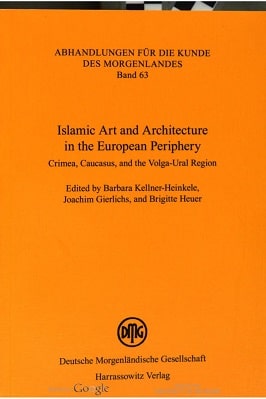
| Islamic Art And Architecture In The European Periphery |
| Brigitte Heuer |
| 300 |
| |
| PDF Direct Download Link |
| Click for Hard Copy from Amazon |
Islamic Art and Architecture in the European Periphery Crimea, Caucasus, and the Volga-Ural Region Edited by Barbara Kellner-Heinkele, Joachim Gierlichs, and Brigitte Heuer
ISLAMIC ART AND ARCHITECTURE IN THE EUROPEAN PERIPHERY
Books Preface
The majority of contributions in the present volume are based on papers presented at the international symposium “Crimea, Caucasus, and the Volga-Ural Region: Islamic Art and Architecture in the European Periphery”, held in Berlin. Sept. 17– 21, 2004. and organized by the editors of this volume.
The symposium brought together 27 scholars from Azerbaijan, Georgia, Germany, the Russian Federation, Turkey, and the Ukraine, as well as from France and the United Kingdom.
In convening this symposium, the organizers attempted to break new ground and give a voice to historians of art and architecture, archaeologists, and curators of museums from what can be termed the European periphery, and to initiate a dialogue with specialists from Western Europe studying art and architecture in the central areas of the Islamic world.
Until then, Islamic art and architecture in the European periphery had not been the subject of international conferences or symposia, nor had Western scholarly publications given much space to contributions dealing with the particular character of Islamic art treasures and architectural monuments in the Black Sea area, the Caucasus, and the Volga-Ural region.
In preparing the symposium, the organizers met with manifold difficulties that need not be spelt out here.
During the symposium, lively discussions on interpretation and approach took place, discussions that shed light on the participants’ diverse academic backgrounds, but also on different levels of financial support, scholarly aims, and public interest.
These differences are also reflected in the symposium papers that the authors revised and sent for publication in this volume.
In addition, the editors faced problems of a technical and intellectual order, which forced them to exclude some of the papers presented at the symposium and submitted for publication.
The editors tried to compensate for this by inviting papers by authors who had not actively participated in the symposium. Oleksa Haiworonski published his paper presented at the symposium in a different context.’
The editors ask the readers to make allowances for the varying quality of the illustrations. The technical means for producing illustrations of a publishable quality still differ considerably from one country to another. Before publication, the original text of most papers has undergone revisions and editorial changes, the extent of which varies from case to case.
In some cases, the editors were not able to clarify vague expressions or incongruities. The editors did not attempt full uniformity in technical matters, respecting the conventions regarding footnotes, transcription, and bibliography the authors had adopted.
A number of papers had to be translated from Russian or German into English. The editors are particularly grateful to Dr. des. Rufat Sattarov (Berlin/Baku) and Dr. Kathrin Möller (Berlin) for their great commitment in the translation of these contributions.
The extensive correspondence with the authors and the demanding preparation of this volume for publication lay in the hands of Brigitte Heuer, who also participated in the translation process.
Without her unrelenting devotion this project would not have materialized. The editors would like to thank all authors and participants for sharing their research findings and expertise.
Without the generous financial support of the VolkswagenStiftung (Hannover) and the Academia Europaea (London) the symposi- um would not have taken place.
Their interest in the important aims of the conference made it a success. Volkswagen Stiftung and Academia Europaea also made possible the printing of this book.
The financial and administrative help of Freie Universität Berlin is also gratefully acknowledged. The editors extend their sincere thanks to Prof. Dr. Florian C. Reiter, the editor of the Abhandlungen für die Kunde des Morgenlandes, for including the volume in this prestigious series.
A Note on Transliteration The spelling of the authors’ family names follows their personal preference. Otherwise, Russian, Ukrainian, and Crimean Tatar (in Cyrillic) names and terms follow the transliteration schemes of the Library of Congress?, with the deviation that ‘ and I are transliterated simply as ‘i’ and ‘ts’, to and a are rendered as ‘yu’ and ‘ya’. For Bashkir, see the note on page 145.
Turkish names and terms are spelt according to modern Turkish orthography. In the case of Crimean Tatar names and terms that are found in different spellings in scholarly literature the spelling preferred by the author has been retained.
To read more about the Islamic Art And Architecture In The European Periphery book Click the download button below to get it for free
or
Report broken link
Support this Website
for websites